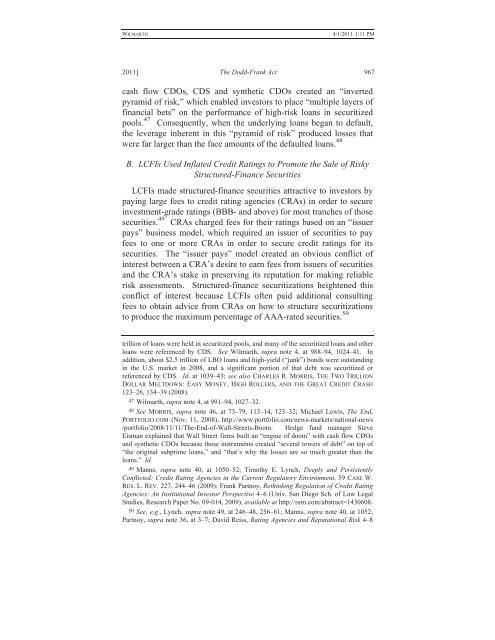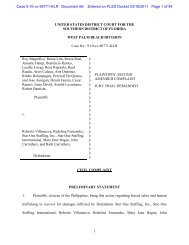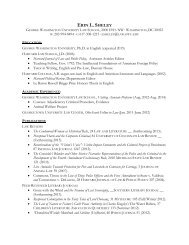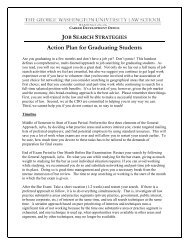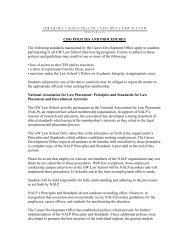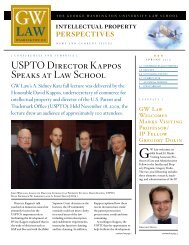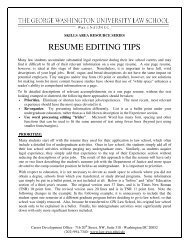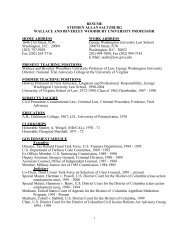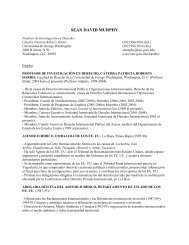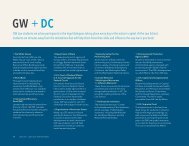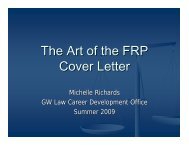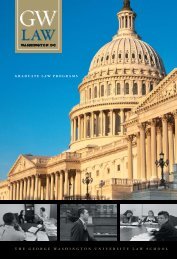CLE Materials for Panel #1 - George Washington University Law ...
CLE Materials for Panel #1 - George Washington University Law ...
CLE Materials for Panel #1 - George Washington University Law ...
Create successful ePaper yourself
Turn your PDF publications into a flip-book with our unique Google optimized e-Paper software.
WILMARTH<br />
4/1/2011 1:11 PM<br />
2011] The Dodd-Frank Act 967<br />
cash flow CDOs, CDS and synthetic CDOs created an “inverted<br />
pyramid of risk,” which enabled investors to place “multiple layers of<br />
financial bets” on the per<strong>for</strong>mance of high-risk loans in securitized<br />
pools. 47 Consequently, when the underlying loans began to default,<br />
the leverage inherent in this “pyramid of risk” produced losses that<br />
were far larger than the face amounts of the defaulted loans. 48<br />
B. LCFIs Used Inflated Credit Ratings to Promote the Sale of Risky<br />
Structured-Finance Securities<br />
LCFIs made structured-finance securities attractive to investors by<br />
paying large fees to credit rating agencies (CRAs) in order to secure<br />
investment-grade ratings (BBB- and above) <strong>for</strong> most tranches of those<br />
securities. 49 CRAs charged fees <strong>for</strong> their ratings based on an “issuer<br />
pays” business model, which required an issuer of securities to pay<br />
fees to one or more CRAs in order to secure credit ratings <strong>for</strong> its<br />
securities. The “issuer pays” model created an obvious conflict of<br />
interest between a CRA’s desire to earn fees from issuers of securities<br />
and the CRA’s stake in preserving its reputation <strong>for</strong> making reliable<br />
risk assessments. Structured-finance securitizations heightened this<br />
conflict of interest because LCFIs often paid additional consulting<br />
fees to obtain advice from CRAs on how to structure securitizations<br />
to produce the maximum percentage of AAA-rated securities. 50<br />
trillion of loans were held in securitized pools, and many of the securitized loans and other<br />
loans were referenced by CDS. See Wilmarth, supra note 4, at 988–94, 1024–41. In<br />
addition, about $2.5 trillion of LBO loans and high-yield (“junk”) bonds were outstanding<br />
in the U.S. market in 2008, and a significant portion of that debt was securitized or<br />
referenced by CDS. Id. at 1039–43; see also CHARLES R. MORRIS, THE TWO TRILLION<br />
DOLLAR MELTDOWN: EASY MONEY, HIGH ROLLERS, AND THE GREAT CREDIT CRASH<br />
123–26, 134–39 (2008).<br />
47 Wilmarth, supra note 4, at 991–94, 1027–32.<br />
48 See MORRIS, supra note 46, at 73–79, 113–14, 123–32; Michael Lewis, The End,<br />
PORTFOLIO.COM (Nov. 11, 2008), http://www.portfolio.com/news-markets/national-news<br />
/portfolio/2008/11/11/The-End-of-Wall-Streets-Boom. Hedge fund manager Steve<br />
Eisman explained that Wall Street firms built an “engine of doom” with cash flow CDOs<br />
and synthetic CDOs because those instruments created “several towers of debt” on top of<br />
“the original subprime loans,” and “that’s why the losses are so much greater than the<br />
loans.” Id.<br />
49 Manns, supra note 40, at 1050–52; Timothy E. Lynch, Deeply and Persistently<br />
Conflicted: Credit Rating Agencies in the Current Regulatory Environment, 59 CASE W.<br />
RES. L.REV. 227, 244–46 (2009); Frank Partnoy, Rethinking Regulation of Credit Rating<br />
Agencies: An Institutional Investor Perspective 4–6 (Univ. San Diego Sch. of <strong>Law</strong> Legal<br />
Studies, Research Paper No. 09-014, 2009), available at http://ssrn.com/abstract=1430608.<br />
50 See, e.g., Lynch, supra note 49, at 246–48, 256–61; Manns, supra note 40, at 1052;<br />
Partnoy, supra note 36, at 3–7; David Reiss, Rating Agencies and Reputational Risk 4–8


